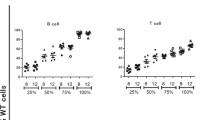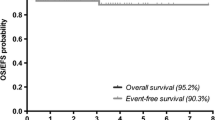Summary
This study uses bone marrow transplantation (BMT) between congenic strains of mice as an experimental model to examine enzyme replacement therapy of lysosomal storage diseases. Bone marrow cells from donor mice which have normal levels of the lysosomal enzyme β-glucuronidase (Gus), which is heat-stable, rapidly repopulated the haematopoietic compartment of irradiated recipient mice which have only low levels of a thermolabile form of this enzyme. Gus activity was found to increase progressively in the tissues of the recipients, including the liver, heart and skeletal muscle. Elevated levels were also observed in the kidney and brain. The increase in enzyme activity in the host tissues was not due to the presence of contaminating blood cells, but rather to the acquisition of new, heat-stable enzyme from the donor bone marrow cells. High levels of Gus activity persisted for at least 72 weeks, showing the potential therapeutic value of BMT for enzyme deficiency diseases.
Similar content being viewed by others
References
Adinolfi M, Akle C, McColl I et al (1982) Expression of HLA antigens B2 microglobulin and enzymes by human amniotic epithelial cells.Nature 295: 325–327.
Beauchamp JR, Partridge TA, Olsen I (1990) Acquisition of a lysosomal enzyme by myoblasts in tissue culture.J Cell Physiol 144: 166–174.
Birkenmeier EH, Baker J, Volger C et al (1991) Increased life span and correction of metabolic defects in murine mucopolysaccharidosis type VII after syngeneic bone marrow transplantation.Blood 78: 3081–3092.
Bou-Gharios G, Moss J, Olsen I (1991) Localization of lysosomal antigens in activated T-lymphocytes.Histochem J 23: 474–482.
Brady RO (1984) Enzyme replacement in the sphingolipidoses. In Barranger JD, Brady RO, eds.Molecular Basis of Lysosomal Storage Disorders. New York: Academic Press, 462–475.
Breider MA, Shull RM, Constantopoulos G (1989) Long-term effects of bone marrow transplantation in dogs with mucopolysaccharidosis I.Am J Pathol 134: 677–692.
Dean MF, Muir H, Benson PF, Button LR, Boylston A, Mowbray J (1976) Enzyme replacement therapy by fibroblast transplantation in a case of Hunter syndrome.Nature 261: 323–325.
Dean MF, Stevens RL, Muir H et al (1979) Enzyme replacement therapy by fibroblast transplantation.J Clin Invest 63: 138–145.
Dekaban AS, Holden KR, Constantopoulos G (1972) Effects of fresh plasma or whole blood transfusion on patients with various types of mucopolysaccharidosis.Pediatrics 50: 688–692.
Desnick RJ, Allen KY, Simmons RL et al (1973)Fabry Disease: Correlation of the Enzymic Deficiency by Renal Transplantation. New York: Alan R. Liss, 88–96.
Di Ferranti N, Nichols BL, Donnelly PV, Neri G, Hrgovcic R, Berglund RK (1971) Induced degradation of glycosaminoglycans in Hurler's and Hunter's syndrome by plasma infusion.Proc Natl Acad Sci USA 68: 303–307.
Gasper PW, Thrall MA, Wenger DA et al (1984) Correction of feline arylsulphatase B deficiency (mucopolysaccharidosis VI) by bone marrow transplantation.Nature 312: 467–469.
Groth CG, Ringden O (1984) Transplantation in relation to the treatment of inherited diseases.Transplantation 38: 319–327.
Haubeck HD, Kolsch E, Imort M, Hasilik A, von Figura K (1985) Natural killer cell-mediated cytotoxicity does not depend on recognition of mannose 6-phosphate residues.J Immunol 134: 65–69.
Hobbs JR (1985) Correction of 34 genetic diseases by displacement bone marrow transplantation.Plasma Ther Transfus Technol 6: 221–246.
Hobbs JR, Hugh-Jones K, Barrett AJ et al (1981) Reversal of clinical features of Hurler's disease and biochemical improvement after treatment by bone-marrow transplantation.Lancet 2: 709–712.
Hoogerbrugge PM, Poorthuis BJHM, Mulder AH et al (1987) Correction of lysosomal enzyme deficiency in various organs of β-glucuronidase-deficient mice by allogeneic bone marrow transplantation.Transplantation 43: 609–614.
Hoogerbrugge PM, Poorthuis BJHM, Romme AE, van de Kamp JJP, Wagemaker G, van Bekkum D (1988). Effect of bone marrow transplantation on enzyme levels and clinical course in neurologically affected Twitcher mouse.J Clin Invest 81: 1790–1794.
Hug G, Schubert WK (1967) Lysosomal in type II glycogenesis: changes during administration of an extract from Aspergillus niger.J Cell Biol 35: C1-C5.
Hugh-Jones K, Hobbs J, Chambers D et al (1984) Bone marrow transplantation in mucopolysaccharidoses. In Barranger JD, Brady RO, eds.Molecular Basis of Lysosomal Storage Disorders. New York: Academic Press, 411–428.
Krivit W, Paul NP (1986)Bone Marrow Transplantation for Treatment of Lysosomal Storage Diseases. New York: Alan R. Liss, 202.
Neufeld EF (1980) The uptake of enzymes into lysosomes: An overview. In Desnick RJ, ed.Enzyme Therapy in Genetic Diseases: 2, Birth defects. New York: Alan R. Liss, 77–84.
Neufeld EF (1981) Lysosomal enzymes: Recognition and processing of lysosomal enzymes in cultured fibroblast. In Callahan JW, Lowden JA eds.Lysosomes and Lysosomal Storage Diseases. New York: New Raven Press, 41–60.
Neuwelt EA, Barranger JA, Brady RO (1981) Delivery of hexosaminidase A to the cerebrum after osmotic modification of the blood-brain barrier.Proc Natl Acad Sci USA 78: 5838.
Olsen I, Dean MF, Harris G, Muir H (1981) Direct transfer of a lysosomal enzyme from lymphoid cells to deficient fibroblasts.Nature 291: 244–247.
Olsen I, Dean MF, Muir H, Harris G (1982) Acquisition of β-glucuronidase activity by deficient fibroblasts during direct contact with lymphoid cells.J Cell Sci 55: 211–231.
Olsen I, Muir H, Smith R, Fensom A, Watt DJ (1983) Direct enzyme transfer from lymphocytes is specific.Nature 306: 75–77.
Paigen K (1989) Mammalian β-glucuronidase: Genetics, molecular biology and cell biology. In Cohn WE, Moldave K, eds.Progress in Nucleic Acid Research and Molecular Biology. New York: Academic Press, 155.
Pfister K, Watson G, Chapman V, Paigen K (1984) Kinetics of β-glucuronidase induction by androgen: genetic variation in the first order rate constant.J Biol Chem 259: 5816.
Reuser AJJ, Kroos MA, Ponne NJ et al (1984) Uptake and stability of human and bovine acid α-glucosidase in cultured fibroblasts and skeletal muscle cells from glycogenosis type II patients.Exp Cell Res 155: 178–189.
Sakiyama T, Tsuda M, Owada M, Joh K, Miyawaki S, Kitagawa T (1983) Bone marrow transplantation for Niemann-Pick mice.Biochem Biophys Res Commun 113: 605–610.
Slavin S, Yatzin S (1980) Correction of enzyme deficiency in mice by allogeneic bone marrow transplantation with total lymphoid irradiation.Science 210: 1150–1151.
Suzuki K, Hoogerbrugge PM, Poorthuis BJHM, van Bekkum DW, Suzuki K (1988) The Twitcher mouse central nervous system pathology after bone marrow transplantation.Lab Invest 58: 301–308.
Taylor RM, Stewart GJ, Farrow BRJ, Healy PJ (1986) Enzyme replacement in nervous tissue after allogeneic bone-marrow transplantation for fucosidosis in dogs.Lancet 2: 772–774.
Taylor RM, Stewart GJ, Farrow BRH (1989) Improvement in the neurologic signs and storage lesions of fucosidosis in dogs given marrow transplants at an early age.Transplant Proc 21: 3818–3819.
van der Ploeg AT, Kroos MA, Willemsen R, Brons NHC, Reuser AJJ (1991) Intravenous administration of phosphorylated acid α-glucosidase leads to uptake of enzyme in heart and skeletal muscle of mice.J Clin Invest 87: 513–518.
Wenger DA, Inui K (1984) Studies on the sphingolipid activator protein for the enzymatic hydrolysis of GM1-ganglioside and sulfatide. In Barranger RJ, Brady RO, eds.Molecular Basis of Lysosomal Storage Disorders. London: Academic Press, 61–78.
Whitley CB, Ramsay NKC, Kersey JH, Krivit W (1986) Bone marrow transplantation for Hurler syndrome: assessment of metabolic correction. In Krivit W, Paul NW, eds.Bone Marrow Transplantation for Treatment of Lysosomal Storage Diseases. New York: Alan R. Liss, 7–24.
Yeager AM (1988) Bone marrow transplantation in children.Pediatr Ann 17: 694–714.
Yeager AM, Brennan S, Tiffany C, Moser HW, Santos GW (1984) Prolonged surival and remyelination after hematopoietic cell transplantation in the Twitcher mouse.Science 225: 1052–1054.
Author information
Authors and Affiliations
Rights and permissions
About this article
Cite this article
Bou-Gharios, G., Adams, G., Pace, P. et al. Long-term effects of bone marrow transplantation on lysosomal enzyme replacement in β-glucuronidase-deficient mice. J Inherit Metab Dis 15, 899–910 (1992). https://doi.org/10.1007/BF01800230
Received:
Accepted:
Issue Date:
DOI: https://doi.org/10.1007/BF01800230




